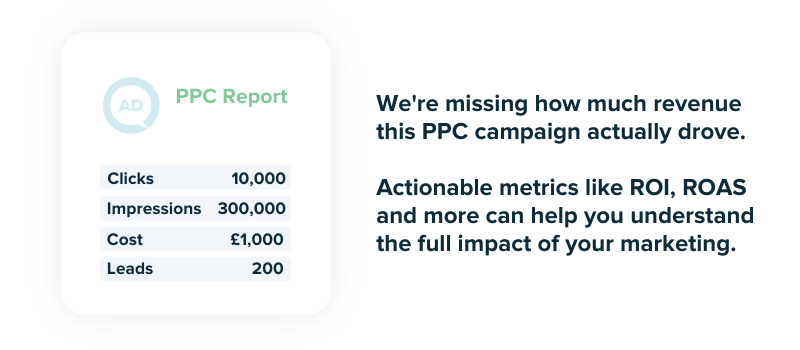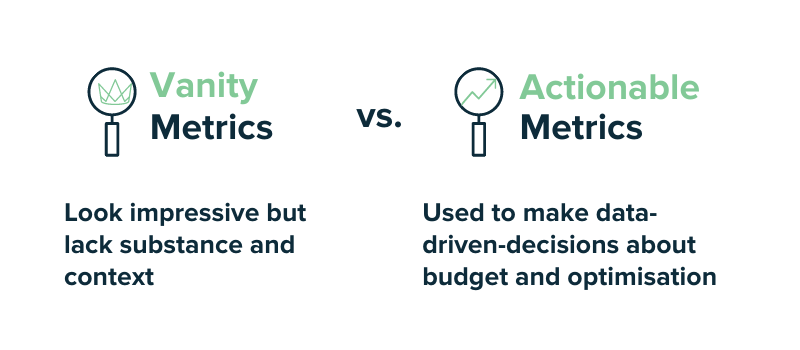Distinguishing between vanity metrics and actionable metrics is an important step for any marketer. This blog will show you how to determine which metrics you need to track, and how to get the data you want, where you need it most.
Pressing ‘publish’ on a social post, a new blog or an email marketing campaign can be stressful. You’re already thinking about how many people are going to look at it and how many will engage.
Of course, the trick to marketing is getting eyeballs on your content.
But that’s not all.
Marketing is about communicating a need for your product or service in a way that convinces a user to purchase.
So, while it might be important to know how many people viewed your latest blog, or how many liked your latest social post, what does it actually mean?
By comparing vanity metrics and actionable metrics, you can better understand how your marketing is driving users through your sales funnel.
It means you can definitively prove how your work is supporting revenue growth. And who doesn’t want to hear that?
Keep reading to learn:
So, let’s get started.
Vanity metrics are metrics that make you look good but aren’t indicative of real performance and don’t help you define your marketing strategy.

Often, vanity metrics are exciting to look at, monitor and share because they can give the appearance of improvement or success.
However, vanity metrics tend to be uncontrollable and difficult to repeat in a meaningful way.
Don’t be confused though, there’s nothing wrong with measuring and even taking pride in these metrics. But, they shouldn’t be used on their own to lead a marketing strategy.
Related: How to measure marketing ROI
And remember, any metric can become a vanity metric.
The key is understanding the implication of the data and how you’re analysing it and using it within your marketing strategy.
They’re generally overly simplified, lack nuance and context or are misleading. So, it’s important to make sure you’re aware of which metrics you’re tracking and the role they play in how you define and develop your marketing.
Related: How best to measure marketing performance
One great example of a vanity metric is social followers. Marketing teams chase high growth on social media, but why?
Because it looks impressive?
While you might have a million followers on social media, how many of those followers actively buy from your company? While it’s a great statistic to share it only highlights the potential of your marketing. What this stat needs is nuance and context.
For example:
Social following is an obvious vanity metric. But there are other, much more contentious statistics to be mindful of.
Imagine you’re a PPC marketer. Chances are you’re tracking metrics like impressions and clicks. Perhaps you’re even tracking leads through conversions.
But this only gives a partial picture of the impact of your PPC campaign. For us, it’s missing the most important metric of all: revenue.
Related: Track more than just clicks with PPC conversion tracking
Let’s use an example. A PPC marketer creates a report for their work on ads for the last month. They generated 10,000 clicks and over 300,000 impressions for a cost of £1,000. And from that, they converted 200 leads.

Impressive? If only one lead converts into a sale of £250 then that’s a loss of £750. If only 4 leads convert into sales of £1,000 then they only just break even. Context around the full customer journey is key to turning vanity metrics into actionable metrics.
Actionable metrics are ones that tie specific actions to observed results. This means metrics that highlight what’s working, and what isn’t.

Related: Measuring marketing KPIs that matter
These metrics are an absolute must for marketers, both holistically and across individual channels. They’ll allow you to get a better understanding of how you can optimise your outputs and drive more meaningful actions across your marketing channels and campaigns.
But remember, actionable metrics will be unique from company to company. What works for one team might not work for another, and so defining your actionable metrics is key. Keep reading to learn how.
One key example of an actionable metric is revenue. It’s our go-to metric of choice as it’s measurable, actionable and scalable.
⚡️ Pro Tip
Want to centre your marketing reporting around revenue? We don’t blame you! It’s the best metric to track, evidence and optimise your marketing with.
Download our guide to closed-loop marketing attribution to see how it can support you get revenue data where you need it.
Think about it like this. If you’re testing two campaigns using the same amount of budget, you need a common denominator to measure them by. If you measure the revenue generated by these two campaigns then you can definitively prove which one was more successful and why.
It gives you clear cut data that you can then use to scale your marketing.
Other actionable metrics could include cost per lead, cost per sale, customer acquisition cost, customer lifetime value and more.
Vanity metrics are more often than not, more exciting and more easily obtained. It takes a few seconds to log onto Instagram to view your followers. It takes mere minutes to view your monthly traffic in Google Analytics.

But it’s more than just time stopping marketers from using actionable metrics. Here are 3 major reasons:
If you work in eCommerce then you can easily pinpoint which channels and campaigns are driving revenue as it’ll all come through to your Google Analytics account. But what if you have to drive leads via call, form fill, live chat or more?
Lead generation tracking isn’t easy and many marketers struggle to properly track conversions. In fact, we found that 62% of marketers using phone calls as a conversion tool struggled to track it.
Related: Read our full report into the reporting and attribution actions of over 200 marketers
Ok, ok, you might be able to track your leads and relate them back to the source. But how do you tie in closed revenue?
Can you definitively say, we drove 100 leads via PPC and of these, 25 closed into a sale resulting in £30,000 in revenue?
If not, you’re missing a trick. But don’t worry, you’re not alone. Revenue attribution isn’t easy. It’s why you need marketing attribution tools like ours to help you fill the data gap. With it, you’ll be able to see how much revenue each marketing channel, campaign, ad and keyword is driving.
Related: What is marketing attribution and why do you need it?
Vanity metrics are one clear point in time, with no context or nuance. Actionable metrics have context. But that context now includes longer and longer customer journeys.
And within those customer journeys comes more and more touchpoints for marketers to manage and make sense of.
Look at it like this.
A user visits your website over 20 times. The first time they visited was via a social referral.
Now your vanity metrics have this user included as one of 10,000 other social followers.
But, without a marketing attribution tool, you can’t tie the importance of this social referral back to their closed revenue 20 touchpoints later.
Ok, so now we know more about what vanity metrics and actionable metrics are and why they can be difficult to measure.
So how do you determine which metrics to track?
If you establish key marketing goals, then you can then associate actionable metrics to each of these goals. It will allow you to stay targeted in what you’re trying to achieve, and how you’re going to achieve and measure it.
Some marketing goals could include:
Then, we would think about which actionable metrics we need to focus on to measure these goals. For these it would probably be:
You’ll likely already have a marketing report in place. And chances are, it takes a fair amount of time to collect and collate these stats into one place?
This is a prime time to sift through your data and better understand what purpose your marketing metrics are serving.
While vanity metrics still have value in a marketing report, you need to be sure that they’re just helping frame the narrative, as opposed to leading it.
Pick out metrics that support your main marketing goals, and help add value and structure.
For example, let’s say you look at sessions on your website each month.
You can track the fluctuation in number and you can provide some small analysis as to why this might be happening.
However, if you can’t definitively correlate changes to marketing campaigns, then your data is only telling you part of the story.
It isn’t too difficult to turn vanity metrics into actionable insights. Below is a list of some common ones to get you started. Remember, all you need to do is provide context and nuance to your data.
| Vanity Metric | Actionable Metric | How to change it |
|---|---|---|
| Clicks and conversions | Revenue and cost per sale | With a marketing attribution solution like Ruler, you can better optimise your marketing based on what drives revenue, not just clicks. |
| Sessions | Session source and site engagement | A lot of people might land on your site but leave right away. Or they might not engage with your content. What use is a website if it doesn’t convert its visitors?
By monitoring and filtering your website visitors and analysing their engagement, you can get granular with what works and what doesn’t. |
| Social followers | Social referrals and engagement | A large social following highlights your channel’s potential. But, it doesn’t guarantee sales from social. Instead, look at social referrals and your engagement across key channels. |
| Clicks to call | Call sources and conversions | With call tracking software like Ruler you can track and record your calls. Plus, you can see calls through the full customer journey and how they result in revenue. |
Remember, marketing attribution and call tracking is a viable way to add context to your data.
By tracking revenue attribution, you can quickly understand what’s working, and what isn’t.
⚡️ Pro Tip
Learn exactly what revenue attribution is and how it can help you better strategies. Attributing revenue will give you a clear cut advantage over your competitors and improve your bottom line.
And there you have it. A comparison of vanity metrics and actionable metrics plus how you can redirect your reporting.
With actionable metrics in place, you’ll be in a stronger position to make clear budgetary decisions about your paid advertising, optimise your team’s time and resources to the channels that work best and report back on what really matters most; revenue.
Remember, marketing attribution is a great way to transform weaker vanity metrics into actionable ones.
In the meantime, read more about how track your offline conversions and link them back to your marketing.
Or, book a demo with our team to see how Ruler can help you connect the dots between sales and marketing.